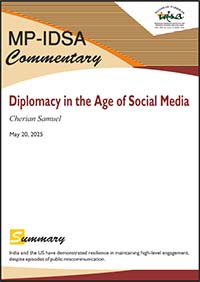Diplomacy in the Age of Social Media
- May 20, 2025 |
- IDSA Comments
In an age of social media driven diplomacy in international relations, the messaging on these platforms have become a new variable in the conduct of diplomatic relations. The self-reinforcing cycle of messaging, responses and subsequent amplification over other platforms and mainstream media has complicated the work of diplomats and public spokespersons, who must now respond even more rapidly to evolving developments. This was most recently seen in the wake of developments following the terrorist attack in Pahalgam, Jammu and Kashmir on 22 April 2025 which resulted in the loss of 26 civilian lives. Indian forces took out nine terrorist strongholds, five located in Pakistan Occupied Kashmir (POK) and four in Pakistan’s Punjab province, in the early hours of 7 May 2025, targeting training camps linked to designated terror organisations such as the Jaish-e-Mohammad and the Lashkar-e-Taiba.
In previous conflicts, the US has restrained Pakistan from committing further follies beyond a point, and it turned out to be no different this time around. President Donald Trump has been using his Truth Social platform as the main source of communication ever since his re-election. On 22 April 2025, Trump put out a message about the ‘deeply disturbing news out of Kashmir’ and said that the US ‘stands strong with India against terrorism’.[1]
In subsequent messages beginning 10 May, Trump posted about the ceasefire agreed to between the two countries, apparently through US mediation. The next day, Trump praised the leadership of India and Pakistan, calling their decision to halt hostilities “historic and heroic”[2]. He hinted at future trade agreements with both nations and credited his trade-based diplomacy for preventing further conflict. He also described his intervention in the India–Pakistan conflict as a “bigger success than I’ll ever be given credit for” [3]. President Trump expanded upon this narrative in the following days, reiterating it in various fora and media interviews. Unlike previous presidencies, transcripts of oral remarks by the President have not been made available by the White House.
A number of statements have come out of the US State Department which may be taken to be the official record. According to a readout from the State Department, Secretary of State Marco Rubio spoke with External Affairs Minister Subrahmanyam Jaishankar on 8 May 2025, emphasising the need for immediate de-escalation in regional tensions. He expressed US support for direct dialogue between India and Pakistan, encouraging continued efforts to improve communication.[4]
Additionally, Secretary Rubio reiterated his condolences for the terrorist attack in Pahalgam and reaffirmed the United States’ commitment to working with India in counterterrorism efforts. Rubio also spoke with Pakistan Prime Minister Sharif and emphasised the need for immediate de-escalation. He expressed US support for direct dialogue between India and Pakistan and encouraged continued efforts to improve communications. He reiterated his calls for Pakistan to take concrete steps to end any support for terrorist groups. [5]
A second statement coming out of the State Department was regarding the ceasefire between India and Pakistan on 10 May 2025. According to the State department statement, Vice President J.D. Vance and Secretary of State Rubio engaged with senior officials from both nations over 48 hours, including Prime Ministers Narendra Modi and Shehbaz Sharif, External Affairs Minister Jaishankar, Pakistan Chief of Army Staff Asim Munir, and National Security Advisors Ajit Doval and Asim Malik, to negotiate an immediate halt to hostilities.[6]
This statement was at variance with an interview by Vice President Vance, only a day earlier, to Fox News wherein he stated that the US will not intervene in the ongoing India–Pakistan conflict, calling it “fundamentally none of our business”[7]. He emphasised that while the US is concerned about tensions between nuclear powers, it cannot control the actions of India or Pakistan and will instead encourage diplomatic de-escalation. Whilst the exact sequence of events, and if at all they occurred, is as yet, unclear and newspaper reportage point to multiple versions of the truth, speculation and misrepresentation would only serve the cause of those inimical to the relationship.
The Indian government has categorically maintained that the ceasefire was arrived at and implemented through direct communication between the Directors General of Military Operations (DGMOs) of India and Pakistan. Press briefings and official statements from the Ministry of External Affairs confirmed that discussions were confined to military channels and did not incorporate issues of trade or third-party involvement. Furthermore, India’s longstanding policy strongly opposes any third-party mediation on the Kashmir dispute, underscoring that all substantive dialogue with Pakistan must be strictly bilateral.
In his address to the nation on 12 May 2025, Prime Minister Modi articulated a clear framework for India’s future engagement with Pakistan.[8] He asserted that any act of terrorism would be treated as an act of war. The PM clarified that any conversation with Pakistan would be limited to two issues—the cessation of terrorism originating from Pakistani territory and the return of Pakistan Occupied Kashmir to India. He also reaffirmed that the suspension of the Indus Water Treaty would remain in place until Pakistan provides credible and irreversible evidence of ending support for terrorism. Statements connecting trade as an incentive to facilitate regional agreements were also characterised by the Government of India as inaccurate.[9]
While the foundation of the India–US bilateral cooperation remains strong—built on expanding defence, economic and technological ties—episodes of public miscommunication underscore the ongoing necessity of diplomatic sensitivity. Over the past two decades, dedicated efforts by both governments have resulted in enhanced levels of trust in strategic areas such as counterterrorism, defence collaboration and supply chain resiliency.
Nonetheless, public statements or policy approaches that do not adequately recognise India’s perspectives on matters of sovereignty, bilateralism and regional security can introduce elements of doubt, impacting the solidity of the relationship. Despite these episodic challenges, both sides have demonstrated resilience in maintaining high-level engagement, reaffirming the indispensable and trusted nature of the partnership. This particular episode reveals the necessity for careful management of both substance and optics in diplomacy, particularly in the shadow of persistent regional tensions.
Views expressed are of the author and do not necessarily reflect the views of the Manohar Parrikar IDSA or of the Government of India.
[1] Donald J. Trump, “Deeply disturbing news out of Kashmir…”, Truth Social, 22 April 2025.
[2] Donald J. Trump, “After a long night of talks mediated by the United States…”, Truth Social, 10 May 2025.
[3] Donald J. Trump, “I am very proud of the strong and unwaveringly powerful leadership of India and…”, Truth Social, 11 May 2025.
[4] “Secretary Rubio’s Call with Indian External Affairs Minister Jaishankar”, U.S. Department of State, 8 May 2025.
[5] “Secretary Rubio’s Call with Pakistani Prime Minister Sharif”, U.S. Department of State, 8 May 2025.
[6] “Announcing a U.S.-Brokered Ceasefire between India and Pakistan”, U.S. Department of State, 10 May 2025.
[7] “Vance Says India-Pakistan Conflict is ‘Fundamentally None of Our Business’”, Fox News, 9 May 2025,
[8] “PM Modi’s Address to the Nation”, Doordarshan National,12 May 2025.
[9] “Transcript of Weekly Media Briefing by the Official Spokesperson (May 13, 2025)”, Media Center, Ministry of External Affairs, Government of India, 13 May 2025.






